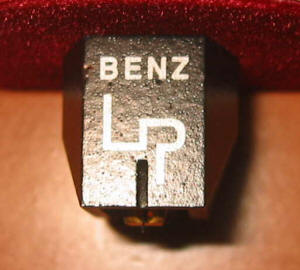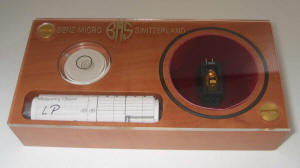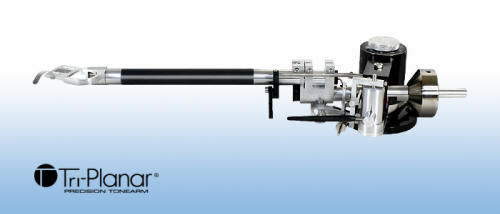Good old Benz-Micro cartridges. They have been around for so long that we take them for granted. As Rodney Dangerfield might have said, they get no respect. After living with the Benz “Ebony” LP moving coil phono cartridge for more than a year, I suggest that this is a mistake. Let’s see if we can elevate the awareness of and respect for the Benz-Micro brand.
Before 10 Audio went live in 1997, I had a Benz Ruby cartridge for a couple of years and recall that it was a fine performer. As with other Benz cartridges I have heard over the years, it consistently and reliably made music with very little editorializing effected by not adding a unique sound of its own. Understated rather than brazen. Refined rather than bombastic. It was easy to live with and enjoy, and as is common with Benz cartridges, completely reliable. The Ruby was also tolerant of minor roughness in handling, if I remember correctly. It was due to this unforced and easygoing nature that I eventually replaced it with something else that I thought would be a little more exciting, a bit more colorful. Interestingly, the replacement remained in my system for a much shorter time than did the Benz, a clear indication that it offered a lower level of listening satisfaction.
Fast forward almost a decade and experience with a wholelotta Koetsus, van den Huls, Lyras, Transfigurations, Denons, Shelters, Ortofons, and Zyxs. While each and every one of these cartridges has something in its sound which delights, none does it all. “All” is the following:
- High resolution from low bass to high treble.
- Fast and dynamic sound, able to present the excitement and energy of live music.
- Realistic presentation of singing voices with an easy ability to imagine real people present in the listening room.
- Consistent ability to present difficult instruments, such as piano, cymbals, trumpets, and even violins, with realistic clarity and tactile believability.
- Evenness of tone and consistent quality of sound from low bass to upper treble. This is where most cartridges fail to satisfy long-term.

And so it was with some level of hope but only moderate expectations that the Benz LP would meet these stringent and, so far, unattained criteria for a long-term musical partner. The LP was installed on a Kuzma Stabi Reference turntable with Graham Phantom and Origin Live Conqueror tonearms, and later on a SOTA Cosmos turntable with the Conqueror and Tri-Planar VII tonearms. Phono preamplifiers over this extended period included a Conrad Johnson Premier 15 Series 2, an EAR 88PB, and a Manley Steelhead, in addition to a half dozen others which passed through the system. The best sounding load impedance depended on the phono stage in use. The LP’s 38 Ohm coil resistance suggests loading in the 350 to 750 Ohm range, and I usually preferred around 500 Ohms resistive or 200 Ohms into a moving coil step-up transformer. 47k Ohms was never a satisfactory value.
First impressions are often of those particular sonic traits that become the very reasons to replace the component soon. “Excellent clarity” later becomes “bright and fatiguing”, for example. In the case of the LP, there were two initial stand-out characteristics that did not become tiresome after the honeymoon was over. First, the LP is a dynamic and powerful cartridge, with the speed to make it work. There is nothing polite or reticent in the way the LP effortlessly offers up musical climaxes, drum whacks, cymbal crashes, or the leading edge of any note or sound. It is right there, right now, and hopefully your amplifier has enough power on tap to deal with the instantaneous power requirements without clipping and trashing your tweeters. The reason that this obvious character is a fine long-term attribute is that it is not limited to the bass or other narrow frequency range, but apparent throughout the audible frequency range.
The second immediate impression was that the Benz has exceptional bass retrieval ability. The bass is very deep, very tight and immediate, but also with the resolution to enable each vibration of an acoustic bass string to be clearly heard. There is a new found appreciation for the sound of drums because not just the initial impact is heard, but also the resounding drum head vibrating a split-second later. All bass sounds, from male bass singers to big brass to stringed instruments, and even to special effects, become as easily discernable as is music up in the midrange. This character always lets one hear the maximum bass performance of any other component in the system, whether phono or line preamplifier, cables, amplifier, or loudspeakers.

Very importantly, these two notable traits did not become subtle faults in the weeks and months following the initial installation and audition.
The rest of the audible frequency range easily keeps up with the superb bass. There is a subtle texture to the midrange that gives human voices a realistic presence. Choruses, whether acoustic vocals or studio mixes, have an easy discernibility that provides the listener with the ability to focus on a single singer or the entire presentation. Subtle timing errors in studio overdubs of an individual singer are apparent to a greater degree that with many other cartridges, with the overly clinical Lyra Helikon SL and Titan being exceptions. The perfect balance of a violin’s string to body sound, for example, is very satisfying and enjoyable. The same is true for voices where we hear both the mouth and body in proper proportion. One requirement for this to work properly is that low level resolution is at a very high level, and the LP passes this test easily.
The upper frequencies are the Waterloo of many cartridges. The treble is where they often fail to satisfy. Almost every cartridge mentioned above changes character as the music transitions from the midrange to the upper midrange and lower treble ranges. Most of the Koetsus lose resolution as the frequency increases. Lyras, as noted above, tend to become thin and clinical, and van den Huls also push the higher frequencies a bit more forward. In contrast, the Benz LP remains remarkably consistent, both harmonically and tonally compared to the midrange. There is no change in the character of music from bass to midrange, or midrange to treble. And this is really the key to the LP’s charm and the rare character that makes it worthy of your consideration. One other cartridge in my memory shares this very important trait: the Shelter 90x. Re-reading my review, I see that a reader might be left wondering which cartridge is actually better. I did not have the Shelter available for direct comparison. I suggest that the LP performs at a higher level overall, with greater insight into the meaning and inner emotion of the music.
As the months passed, I occasionally thought a bit more sparkle and life in the upper treble might be a welcome thing. But then some music would have a cymbal crash, or a flute, or a bell. The upper frequency harmonics are in perfect proportion to the fundamental notes. The realism of the initial sound followed by a very long and natural decay would tell me that there was not a problem or lack of high frequency content or resolution. The entire treble is present in full measure when the music requires it, but otherwise the high frequencies are not overdone, not bright, not hard, not thin, nor in any way unnatural or lacking.
Most of my listening was with the superb Tri-Planar VII tonearm. This instrument brought out the best of any cartridge, except for the high mass Koetsu Jade Platinum. The arms in recent use were the Graham Phantom and Origin Live Conqueror. Both the Conqueror and Tri-Planar have a single unbroken wire from cartridge pin to RCA connector. This shared feature is a huge sonic improvement over the multiple connectors in the signal path of the Phantom. Foregoing the quick cartridge changes made possible by the removable Graham arm wand is a small price to pay for a vast reduction in harshness, grain, and loss of resolution which results from the added electrical connections of the Phantom.

The Tri-Planar is very light in weight, weighing about 11 ounces total. In contrast, the Conqueror weighs a little over 2 pounds. The balanced SOTA arm boards for these two arms are not interchangeable! The Tri-Planar is a complex mechanism with adjustments for everything a cartridge might need for optimal performance. Azimuth, VTA, VTF, cueing action, and anti-skate are all adjustable. Every one of the many individual parts is machined and finished to a very high standard and no sense of “garage workshop” manufacturing is present in any part of the assembly. There is a large dial on top of the main tower to adjust VTA, with an engraved scale on the side of the tower to facilitate repeating a VTA setting. If one is careful, this adjustment can be made while a record is playing. Even with all of the possible adjustments, setting up the arm is not overly complex or time consuming. After the adjustments are made, they stay put and no ongoing maintenance is required.
There is a precision, an exactness, to the sound of music with this arm. Not quite as round and full sounding as the Conqueror, the Tri-Planar nevertheless offers a penetrating view into the music that the former arm doesn’t quite pull off. The bass has a bit less weight than the OL arm delivers, but offers an often amazing level of resolution all across the audible range that is very, and often intensely, satisfying. A few years ago, an earlier version of the Tri-Planar, maybe a V or VI, stopped by for a visit. It had Cardas wiring which many people like. I found it to sound hazy and with a subtle but noticeable grain in the upper frequencies. Tri Mai, the owner and maker of the arms for the past several years, is now using a proprietary copper wire that avoids the deficiencies of the earlier wire. The VII has outstanding resolution and freedom from any hint of grain or haze, a freedom that is also offered by the silver-wired Conqueror arm. This clarity provides an extraordinary sense of high frequency resolution and air, sounding as natural and fresh as a clear spring day.
The combination of the SOTA Cosmos and Tri-Planar VII tone arm is really a wonderful pairing. My ending comment in the Cosmos review that it may be the last turntable that I own is also a tribute to the very positive contribution of the Tri-Planar VII tonearm. The sound is clear but not thin, rich but not fat, and revealing but not clinical. The arm itself is completely adjustable but not tweaky.
Other cartridges can offer a different character than you hear from the Benz LP. You can have brighter, leaner, faster, slower, more forward, more laid-back, or just about any other specific trait your heart desires. It is truly a rare phono cartridge that offers so much excellence with faults that are so easy to ignore. You may have noticed that there is no mention here of faults. Very observant! Documenting the faults is a practice that readers of 10 Audio are well aware is one that we often include with great enthusiasm. The lack of their mention here is simply because I have not been aware of any during the Benz’s long and very enjoyable tenure in my listening room.
The sound of a phono cartridge must be considered in the context of the tonearm and turntable with which it is used, and the phono preamplifier and its settings. Given the review system, it is very apparent that the Benz-Micro LP is a thoroughly outstanding phono cartridge with a high resolution, consistent sound that honors all music. The low retipping fee makes long-term ownership a lot less painful than many other cartridges, too. Taking the Benz LP for granted is not recommended.
Overall Rating: 10 LPs, cartridge and arm
10 Audio would like to give a special thanks to Mehran of Sorasound. This review would not have been possible without his kind assistance.
Manufacturer’s links:
Benz-Micro. Link to Musical Surroundings, U.S. Distributor
Tri-Planar
